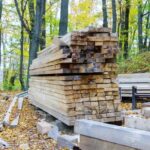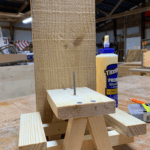Are you wondering how to remove old masking tape from stained woodwork without causing damage? Many homeowners and DIY enthusiasts have faced the frustration of trying to remove old masking tape only to find it has left behind a sticky residue or even stripped the stain from the wood.
In this article, we will discuss the common issues with old masking tape on stained woodwork and provide a step-by-step guide on how to safely and effectively remove it without causing damage.
Old masking tape can become a nightmare when it comes to stained woodwork. The adhesive on the tape can bond tightly with the stain, making it difficult to remove without causing damage. However, with the right materials and techniques, removing old masking tape from stained woodwork can be done effectively and without harming the finish. We will also provide tips for preventing any potential damage while removing old masking tape and share alternative methods for tackling this issue.
In addition, we will cover how to clean and restore the woodwork after removing the old masking tape, ensuring that your stained woodwork maintains its beauty. By following our advice, you can avoid common mistakes while removing old masking tape from stained woodwork and keep your wooden surfaces looking pristine. So let’s dive in and learn how to tackle this common issue.
Materials Needed for Removing Old Masking Tape From Stained Woodwork
When it comes to removing old masking tape from stained woodwork, having the right materials can make the process much easier and more effective. Here are the essential items you will need:
1. Heat Gun or Hair Dryer: Applying heat to the old masking tape can help soften the adhesive, making it easier to remove. A heat gun or a hair dryer set on high heat can be used for this purpose.
2. Plastic Scraper or Credit Card: Once the adhesive has been softened with heat, a plastic scraper or an old credit card can be used to gently lift and remove the old masking tape from the stained woodwork without causing damage.
3. Mineral Spirits or Goo Gone: For any stubborn residue left behind after removing the masking tape, mineral spirits or a commercial adhesive remover like Goo Gone can be applied to dissolve and clean off the remaining adhesive.
4. Clean Cloth: It’s important to have a clean cloth on hand to wipe away any excess mineral spirits or adhesive remover from the woodwork.
5. Fine-grit Sandpaper: In some cases, there may still be some residue left on the woodwork after using an adhesive remover. Fine-grit sandpaper can be used to gently sand away any remaining sticky residue while being careful not to damage the stained finish.
Having these materials ready before starting the removal process will ensure that you’re well-equipped for effectively removing old masking tape from your stained woodwork without causing any damage. Remember to work carefully and patiently, as rushing through this process could lead to unintentional harm to your wood surfaces.
| Materials | Uses |
|---|---|
| Heat Gun/Hair Dryer | Softening adhesive on old masking tape |
| Plastic Scraper/Credit Card | Gently lifting and removing old masking tape |
| Mineral Spirits/Goo Gone | Dissolving and cleaning off stubborn residue |
| Clean Cloth | Wiping away excess solvent from woodwork |
Step-by-Step Guide on How to Remove Old Masking Tape From Stained Woodwork
Removing old masking tape from stained woodwork can be a tricky task, but with the right materials and technique, it can be done effectively. Here’s a step-by-step guide to help you remove old masking tape without damaging the woodwork:
Materials needed:
Steps:
1. Apply heat to the old masking tape: Use a hairdryer or heat gun on low setting to gently warm up the old masking tape. Hold the heat source a few inches away from the tape and move it back and forth to avoid scorching the wood.
2. Peel off the masking tape: Once the adhesive becomes warm and soft, carefully lift up an edge of the tape using a plastic putty knife or scraper. Slowly peel back the tape while continuing to apply heat as needed.
3. Remove any remaining adhesive: Apply a small amount of Goo Gone or adhesive remover to a soft cloth and gently rub it over any leftover adhesive residue. Allow it to sit for a few minutes before wiping it clean with another cloth.
4. Clean and restore the woodwork: After removing all traces of masking tape and adhesive, use a wood cleaner to clean the area thoroughly. Follow up with a wood polish to restore shine and protect the surface.
By following these steps, you can effectively remove old masking tape from stained woodwork without causing damage. However, if you encounter stubborn residue or are unsure about using heat on your specific type of stain, consider seeking professional assistance to avoid any potential harm to your woodwork.
Remember that prevention is key when it comes to minimizing damage from old masking tape on stained woodwork. Always test any cleaning products or methods in an inconspicuous area first, and take your time during the removal process to ensure that you do not accidentally scratch or discolor the surface of your woodwork.
Tips for Preventing Damage to Woodwork While Removing Old Masking Tape
When it comes to removing old masking tape from stained woodwork, it’s important to take precautions to prevent damage to the wood surface. Here are some tips to keep in mind:
Use Heat Carefully
One common method for removing old masking tape is to use heat to soften the adhesive. However, it’s important to use this method carefully, especially on stained woodwork.
Excessive heat can not only damage the finish of the wood, but it can also cause the adhesive to become even more stubborn. Use a hair dryer or heat gun on a low setting and hold it a few inches away from the tape, constantly moving it around to avoid concentrating too much heat in one spot.
Test Solvents on a Small Area
If you’re considering using solvents to remove old masking tape residue, always test them on a small, inconspicuous area of the woodwork first. This will help you determine whether the solvent will cause any damage or discoloration to the wood finish. It’s also important to use solvents in a well-ventilated area and wear gloves to protect your skin.
Peel Slowly and Gently
When actually removing the old masking tape, take your time and peel it off slowly and gently. This will minimize the risk of pulling up any wood finish along with the tape. If you encounter resistance while peeling, stop immediately and try another removal method rather than risking damage to the woodwork.
Alternative Methods for Removing Old Masking Tape From Stained Woodwork
Removing old masking tape from stained woodwork can be a challenging task, but there are several alternative methods that can help make the process easier and more effective. Whether you’re dealing with stubborn residue or delicate wood surfaces, these alternative methods offer different approaches to safely and efficiently remove old masking tape without causing damage to the woodwork.
Here are some alternative methods for removing old masking tape from stained woodwork:
- Use heat: Applying heat to the old masking tape can soften the adhesive, making it easier to peel off. You can use a hair dryer or a heat gun on a low setting to gently warm up the masking tape. Once the adhesive softens, carefully peel off the tape and use a clean cloth to wipe away any residue.
- Oil-based solvents: Oil-based solvents such as WD-40 or cooking oil can help break down the adhesive from old masking tape. Apply a small amount of the solvent to a clean cloth and gently rub it onto the tape residue. Let it sit for a few minutes before using a scraper or your fingers to peel off the softened residue.
- Commercial adhesive removers: There are specific products available in hardware stores that are designed to remove adhesive residue from various surfaces. Look for an adhesive remover that is safe for use on wood surfaces and follow the manufacturer’s instructions for best results.
By using these alternative methods, you can effectively remove old masking tape from stained woodwork without causing any damage to the wood surface. Experiment with these options to find the method that works best for your specific situation while maintaining the beauty of your stained woodwork.
How to Clean and Restore the Woodwork After Removing the Old Masking Tape
After successfully removing the old masking tape from stained woodwork, it’s important to clean and restore the wood to its original beauty. The process involves removing any adhesive residue left behind by the tape and restoring the finish of the wood. Here’s a step-by-step guide on how to clean and restore the woodwork after removing the old masking tape.
First, start by cleaning the surface with a gentle solvent or adhesive remover to remove any remaining adhesive from the old masking tape. Be sure to test the solvent on a small, inconspicuous area of the woodwork first to ensure it doesn’t damage or discolor the finish. Gently rub the solvent onto the affected area using a soft cloth, then wipe it clean with a separate damp cloth.
Next, assess whether there is any damage to the finish of the woodwork caused by the old masking tape. If there are areas where the finish has been compromised, consider using a wood stain or touch-up marker that matches the original color of the wood. Apply it carefully to blend in with the surrounding area, then allow it to dry completely before assessing if further treatment is needed.
Finally, once you have cleaned and repaired any damage caused by removing old masking tape from stained woodwork, consider applying a fresh coat of furniture polish or wax to protect and restore the overall finish of your woodwork. This will help bring back its natural luster and provide a protective layer against future damage.
| Step | Description |
|---|---|
| 1 | Clean surface with gentle solvent or adhesive remover |
| 2 | Assess for any damage to finish; repair as needed with matching stain or touch-up marker |
| 3 | Apply furniture polish or wax for protection and restoration |
Common Mistakes to Avoid When Removing Old Masking Tape From Stained Woodwork
When removing old masking tape from stained woodwork, it’s crucial to avoid common mistakes that can lead to further damage. These mistakes can include using the wrong tools, using harsh chemicals, or applying too much force. By being aware of these mistakes and taking the proper precautions, you can successfully remove old masking tape without causing harm to the woodwork.
Using the Wrong Tools
One common mistake when removing old masking tape from stained woodwork is using the wrong tools. Using sharp objects such as knives or razor blades can result in scratches and gouges on the wood surface. Instead, opt for a plastic putty knife or a heat gun to gently remove the tape without damaging the wood.
Using Harsh Chemicals
Another mistake to avoid is using harsh chemicals to remove old masking tape. Chemical solvents may remove the adhesive but can also strip away the finish or stain on the wood. It’s best to start with gentle methods such as warm water and mild soap before considering stronger solutions. Always test any chemical on a small, inconspicuous area first to ensure it won’t cause damage.
Applying Too Much Force
Lastly, applying too much force when removing old masking tape can cause the wood to splinter or crack. It’s important to be patient and gently work at the edges of the tape until it loosens from the surface. Applying heat with a hair dryer or heat gun can also help soften the adhesive, making it easier to remove without excess force.
By avoiding these common mistakes and following proper removal techniques, you can effectively remove old masking tape from stained woodwork without causing additional damage. Remember to always take your time and proceed with caution to preserve the beauty of your woodwork.
Conclusion
In conclusion, it is essential to take the necessary steps to maintain the beauty of stained woodwork and prevent future damage from masking tape. The process of removing old masking tape from stained woodwork may seem daunting, but with the right materials and techniques, it can be done effectively. By following the step-by-step guide provided in this article and utilizing the tips for preventing damage to woodwork, homeowners can ensure that their stained woodwork remains in pristine condition.
It’s important to remember that patience is key when dealing with old masking tape on stained woodwork. Rushing through the removal process can result in damage to the wood surface, which may require additional repairs. Taking the time to carefully remove the tape and adhesive residue will help preserve the integrity of the wood.
In addition, regular cleaning and maintenance of stained woodwork can help prevent future build-up of adhesive residue. By keeping the wood surfaces clean and well-maintained, homeowners can minimize the need for removing old masking tape in the future. Ultimately, by taking proper care of stained woodwork, homeowners can ensure that it continues to enhance the beauty of their living spaces for years to come.
Frequently Asked Questions
How Do You Get Dried Masking Tape Off Wood?
To remove dried masking tape off wood, you can start by using a hairdryer to heat the tape, making it easier to peel off. Then, apply a small amount of rubbing alcohol or adhesive remover to a cloth and gently rub the residue until it comes off. Be careful not to use anything abrasive that could damage the wood surface.
How Do You Remove Old Stuck Masking Tape?
Removing old stuck masking tape can be done by first softening the adhesive with a mixture of warm water and mild dish soap. Gently rub the solution onto the tape and let it sit for a few minutes before attempting to peel it off with your fingers or a plastic scraper.
Avoid using sharp tools that could scratch or gouge the surface underneath.
How Do You Remove Painters Tape Left on Too Long?
When painter’s tape has been left on too long, you can try applying some heat using a hairdryer to soften the adhesive before carefully peeling it off. If there is any remaining residue, use an adhesive remover or rubbing alcohol on a cloth to gently rub off the remaining sticky residue without damaging the underlying surface.
Be patient and work slowly to avoid causing any damage while removing the leftover tape.

Hi everyone! I’m a woodworker and blogger, and this is my woodworking blog. In my blog, I share tips and tricks for woodworkers of all skill levels, as well as project ideas that you can try yourself.





